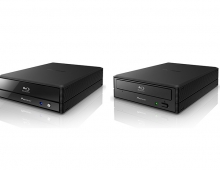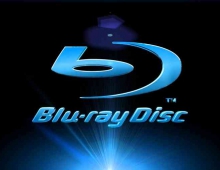
Blu-Ray Vs HD-DVD: The next generation DVD
A division of the DVD Forum will meet in New York next week to vote on a next-generation optical-disk format. Latest information say that its pretty unlikely that Blue Ray will receive official DVD forum backing, as the joint NEC/Toshiba proposal for HD-DVD (AOD) seems to be gaining some momentum (still no final decisions taken though). Whatever happens there will be competing formats during the second half of 2004.
Sixty companies took part in the forum's technical working group to develop the high-definition (HD-DVD) format, and some of them are also members of the opposing Blu-ray Disc ROM (BD-ROM) camp. Blu-ray was developed by 10 powerful consumer electronics companies, including Sony, Philips, Hitachi, Sharp and Samsung. All 10 are members of the DVD Forum's steering committee.
Efforts to control the next-generation format have split the consumer electronics industry in two, and the stakes are high. Whichever format the market eventually embraces is expected to give consumer electronics manufacturers control over the technology that underlies upcoming DVD systems, and to protect them from the price deterioration now being seen in DVD players manufactured largely by Chinese OEMs. Next-generation systems promise to deliver a high-definition movie on a single disk, and are expected to build momentum for HDTV set sales.
Some industry observers believe HD-DVD could offer a smooth, seamless transition from today's standard-definition DVD to high definition, but they also acknowledge that the proposal faces a battle. The HD-DVD camp is hoping to commercialize its products in time for Christmas 2004. BD-ROM proponents are planning to introduce their high-definition optical-disk player, which will not be compatible with the DVD Forum's specification, in late 2005.
While the DVD Forum's technical working groups have already completed round-robin verification tests and approved the HD-DVD spec, it still awaits final approval from the steering committee. The spec that is up for vote this week includes four high-efficiency codecs-H.264, Windows Media9, MPEG-2 or a hybrid of MPEG-2 and H.264. It also specifies a blue-laser diode technology. The proposal is based on Advanced Optical Disc (AOD) technology, co-developed by Toshiba Corp. and NEC Corp. as a successor to the current DVD specification.
Designed to maintain full backward compatibility with current DVD disks, AOD adopts the same bonded-disk structure as the red-laser DVD current systems now in use, including the same thickness of the substrate disk and the same process for replication. But the data capacity is increased three to six times to store a high-definition movie, according to HD-DVD proponents. AOD's disk capacity is 15 Gbytes for a single-layer ROM disk, 30 Gbytes for a dual-layer disk and 20 Gbytes for a single-layer rewritable disk. The dual-layer rewritable disk is provisionally defined as 35 to 40 Gbytes.
The opposing Blu-ray group, meanwhile, is gearing up for the completion of its BD-ROM version 0.9 spec by the end of this year, with its 1.0 spec-the group's first public release of its specification-scheduled in the first quarter of 2004, said Michael Fidler, senior vice president of Sony Corp. of America's Blu-ray Disc Group Division. The Blu-ray group plans to make a big splash at the Consumer Electronics Show in Las Vegas in January with a split-screen public demonstration of DVD vs. BD-ROM, Fidler said.
In contrast to the HD-DVD proposal, BD-ROM rejects the use of a new video compression format and sticks with the same audio/video codecs, such as MPEG-2 and Dolby Digital, that are specified by the U.S. digital HDTV system. While HD-DVD depends on advanced signal processing to increase disk capacity, the BD-ROM format relies on a newly designed optical-disk format and cutting-edge optical pickup to attain a similar goal.
The optical-pickup technology includes a high numerical aperture, 0.85, and a 405-nanometer blue-violet laser using a 0.1-mm cover-layer disk, compared with 0.6 mm in current DVD disks. With its beam spot area reduced to one-fifth that of today's DVD technology, the BD-ROM claims 25-Gbyte capacity per single-layer ROM and 50 Gbytes on a dual-layer BD-ROM disk.
Aside from working on the 0.9 spec, the BD-ROM proponents appear to be doing their best to make the DVD Forum's HD-DVD-related activities irrelevant. With all 10 of Blu-ray's founding members retaining their seats on the DVD Forum's 17-member steering committee, Blu-ray backers either voted “no” or abstained on the HD-DVD proposal at a June meeting. The six companies that voted “yes” included IBM, Intel, NEC, Time Warner and Toshiba. Because a majority of eight steering committee members abstained, the HD-DVD proposal will be voted on again next week.
To remedy the lopsided membership configuration, the DVD Forum has invited three more companies to join the steering committee. Its deadline for self-nomination was Nov. 7. The activities within the steering committee have resulted in some criticism leveled against the Blu-ray group. “The Blu-ray camp has its rights to choose to work outside the DVD Forum,” said one executive in Hollywood who spoke on the condition of anonymity. “But I think they have crossed the line by keeping their seats on the forum's steering committee with no genuine desire to cooperate with the forum. They are there to interfere with AOD and suppress their competitors.”
Others accused the Blu-ray group of a blatant attempt to undermine more than a year's worth of technical development efforts by engineers from 60 companies in the DVD Forum's working group, who labored to complete the HD-DVD proposal.
Many in the Blu-ray camp don't see any conflict of interest, however. Sony's Fidler made it clear that Blu-ray backers “believed in the need for a new organization outside the DVD Forum due to the new technologies the [BD-ROM] format adopted, including a new physical-disk format and laser technology.” Just as the consumer electronics industry moved from infrared with CD to red laser with DVD, and now on to blue laser for high definition, the Blu-ray camp sees it as a natural progression to set up a completely new industry group outside the DVD Forum.
What matters, backers say, is a number of new features they hope to deliver with BD-ROM. Fidler said the proposed HD-DVD format lacks “wow factors,” whereas BD-ROM boasts a new copy protection scheme currently in development by Sony, Philips and Matsushita; a Java programming environment; better navigation and graphics capabilities; Internet connectivity integrated into a BD-ROM player for downloading additional materials, including subtitles for foreign-language content; and plenty of room for data storage.
Unlike current DVD technology, the BD-ROM format uses a much stronger encryption algorithm based on 128-bit AES. It features system renewability for key revocation, and incorporates a physical technology for preventing so-called “bit-by-bit” copying to recordable media. Under this scheme, content providers will physically insert a so-called “ROM mark” onto a prerecorded disk during the mastering process. “Our goal is to prevent not only casual copying, but also professional copying, as much as possible,” said Fidler.
The HD-DVD camp, meanwhile, cites the advantages of an evolutionary rather than revolutionary approach. “Our basic position is to create an HD-DVD format best suited for current DVD customers,” said Hisashi Yamada, a fellow and technology officer at Toshiba's Digital Media Network Co. Rather than a radically different physical format like BD-ROM's, Yamada said, “We really want to keep compatibility with current DVD, while realizing enough capacity for future applications.”
He called HD-DVD's 15-Gbyte ROM capacity “quite enough,” given the recent advent of advanced codecs like H.264 or Windows Media9. One 15-Gbyte disk can contain 132 minutes of film compressed at about 15 Mbits/second, according to Yamada. He also cited HD-DVD's rewritable-disk capacity of 20 Gbytes, and argued that by adopting rather conservative optical features such as a 0.65 numerical aperture, HD-DVD can use a cost-effective plastic lens.
Further, because HD-DVD maintains the same physical-disk format as standard DVD, Yamada stressed that Hollywood studios and replicators can switch from DVD to HD-DVD without changing their production lines.
Yamada and a number of executives, including a few at Hollywood studios, confirmed the readiness of H.264 and Windows Media9 in terms of the picture quality of highly compressed video. “The picture quality is one thing that is not negotiable for us in a studio,” said an industry source. Sony's Fidler, however, believes that adopting a new video codec like H.264 “is not a right strategy.” He said the H.264 infrastructure is not yet in place to support HD-DVD.
Industry watcher Jon Peddie, president of Jon Peddie Research, is among those who believe Blu-ray is “not the answer” for next-generation DVD. He described the technology as something pushed by Sony and others that have heavily invested in the blue-laser technology.
“Blu-ray will be too expensive for the average user,” Peddie said. “The media is too expensive, and it's unlikely many studios will master to it because of the cost and the very low user base.”
Efforts to control the next-generation format have split the consumer electronics industry in two, and the stakes are high. Whichever format the market eventually embraces is expected to give consumer electronics manufacturers control over the technology that underlies upcoming DVD systems, and to protect them from the price deterioration now being seen in DVD players manufactured largely by Chinese OEMs. Next-generation systems promise to deliver a high-definition movie on a single disk, and are expected to build momentum for HDTV set sales.
Some industry observers believe HD-DVD could offer a smooth, seamless transition from today's standard-definition DVD to high definition, but they also acknowledge that the proposal faces a battle. The HD-DVD camp is hoping to commercialize its products in time for Christmas 2004. BD-ROM proponents are planning to introduce their high-definition optical-disk player, which will not be compatible with the DVD Forum's specification, in late 2005.
While the DVD Forum's technical working groups have already completed round-robin verification tests and approved the HD-DVD spec, it still awaits final approval from the steering committee. The spec that is up for vote this week includes four high-efficiency codecs-H.264, Windows Media9, MPEG-2 or a hybrid of MPEG-2 and H.264. It also specifies a blue-laser diode technology. The proposal is based on Advanced Optical Disc (AOD) technology, co-developed by Toshiba Corp. and NEC Corp. as a successor to the current DVD specification.
Designed to maintain full backward compatibility with current DVD disks, AOD adopts the same bonded-disk structure as the red-laser DVD current systems now in use, including the same thickness of the substrate disk and the same process for replication. But the data capacity is increased three to six times to store a high-definition movie, according to HD-DVD proponents. AOD's disk capacity is 15 Gbytes for a single-layer ROM disk, 30 Gbytes for a dual-layer disk and 20 Gbytes for a single-layer rewritable disk. The dual-layer rewritable disk is provisionally defined as 35 to 40 Gbytes.
The opposing Blu-ray group, meanwhile, is gearing up for the completion of its BD-ROM version 0.9 spec by the end of this year, with its 1.0 spec-the group's first public release of its specification-scheduled in the first quarter of 2004, said Michael Fidler, senior vice president of Sony Corp. of America's Blu-ray Disc Group Division. The Blu-ray group plans to make a big splash at the Consumer Electronics Show in Las Vegas in January with a split-screen public demonstration of DVD vs. BD-ROM, Fidler said.
In contrast to the HD-DVD proposal, BD-ROM rejects the use of a new video compression format and sticks with the same audio/video codecs, such as MPEG-2 and Dolby Digital, that are specified by the U.S. digital HDTV system. While HD-DVD depends on advanced signal processing to increase disk capacity, the BD-ROM format relies on a newly designed optical-disk format and cutting-edge optical pickup to attain a similar goal.
The optical-pickup technology includes a high numerical aperture, 0.85, and a 405-nanometer blue-violet laser using a 0.1-mm cover-layer disk, compared with 0.6 mm in current DVD disks. With its beam spot area reduced to one-fifth that of today's DVD technology, the BD-ROM claims 25-Gbyte capacity per single-layer ROM and 50 Gbytes on a dual-layer BD-ROM disk.
Aside from working on the 0.9 spec, the BD-ROM proponents appear to be doing their best to make the DVD Forum's HD-DVD-related activities irrelevant. With all 10 of Blu-ray's founding members retaining their seats on the DVD Forum's 17-member steering committee, Blu-ray backers either voted “no” or abstained on the HD-DVD proposal at a June meeting. The six companies that voted “yes” included IBM, Intel, NEC, Time Warner and Toshiba. Because a majority of eight steering committee members abstained, the HD-DVD proposal will be voted on again next week.
To remedy the lopsided membership configuration, the DVD Forum has invited three more companies to join the steering committee. Its deadline for self-nomination was Nov. 7. The activities within the steering committee have resulted in some criticism leveled against the Blu-ray group. “The Blu-ray camp has its rights to choose to work outside the DVD Forum,” said one executive in Hollywood who spoke on the condition of anonymity. “But I think they have crossed the line by keeping their seats on the forum's steering committee with no genuine desire to cooperate with the forum. They are there to interfere with AOD and suppress their competitors.”
Others accused the Blu-ray group of a blatant attempt to undermine more than a year's worth of technical development efforts by engineers from 60 companies in the DVD Forum's working group, who labored to complete the HD-DVD proposal.
Many in the Blu-ray camp don't see any conflict of interest, however. Sony's Fidler made it clear that Blu-ray backers “believed in the need for a new organization outside the DVD Forum due to the new technologies the [BD-ROM] format adopted, including a new physical-disk format and laser technology.” Just as the consumer electronics industry moved from infrared with CD to red laser with DVD, and now on to blue laser for high definition, the Blu-ray camp sees it as a natural progression to set up a completely new industry group outside the DVD Forum.
What matters, backers say, is a number of new features they hope to deliver with BD-ROM. Fidler said the proposed HD-DVD format lacks “wow factors,” whereas BD-ROM boasts a new copy protection scheme currently in development by Sony, Philips and Matsushita; a Java programming environment; better navigation and graphics capabilities; Internet connectivity integrated into a BD-ROM player for downloading additional materials, including subtitles for foreign-language content; and plenty of room for data storage.
Unlike current DVD technology, the BD-ROM format uses a much stronger encryption algorithm based on 128-bit AES. It features system renewability for key revocation, and incorporates a physical technology for preventing so-called “bit-by-bit” copying to recordable media. Under this scheme, content providers will physically insert a so-called “ROM mark” onto a prerecorded disk during the mastering process. “Our goal is to prevent not only casual copying, but also professional copying, as much as possible,” said Fidler.
The HD-DVD camp, meanwhile, cites the advantages of an evolutionary rather than revolutionary approach. “Our basic position is to create an HD-DVD format best suited for current DVD customers,” said Hisashi Yamada, a fellow and technology officer at Toshiba's Digital Media Network Co. Rather than a radically different physical format like BD-ROM's, Yamada said, “We really want to keep compatibility with current DVD, while realizing enough capacity for future applications.”
He called HD-DVD's 15-Gbyte ROM capacity “quite enough,” given the recent advent of advanced codecs like H.264 or Windows Media9. One 15-Gbyte disk can contain 132 minutes of film compressed at about 15 Mbits/second, according to Yamada. He also cited HD-DVD's rewritable-disk capacity of 20 Gbytes, and argued that by adopting rather conservative optical features such as a 0.65 numerical aperture, HD-DVD can use a cost-effective plastic lens.
Further, because HD-DVD maintains the same physical-disk format as standard DVD, Yamada stressed that Hollywood studios and replicators can switch from DVD to HD-DVD without changing their production lines.
Yamada and a number of executives, including a few at Hollywood studios, confirmed the readiness of H.264 and Windows Media9 in terms of the picture quality of highly compressed video. “The picture quality is one thing that is not negotiable for us in a studio,” said an industry source. Sony's Fidler, however, believes that adopting a new video codec like H.264 “is not a right strategy.” He said the H.264 infrastructure is not yet in place to support HD-DVD.
Industry watcher Jon Peddie, president of Jon Peddie Research, is among those who believe Blu-ray is “not the answer” for next-generation DVD. He described the technology as something pushed by Sony and others that have heavily invested in the blue-laser technology.
“Blu-ray will be too expensive for the average user,” Peddie said. “The media is too expensive, and it's unlikely many studios will master to it because of the cost and the very low user base.”





















